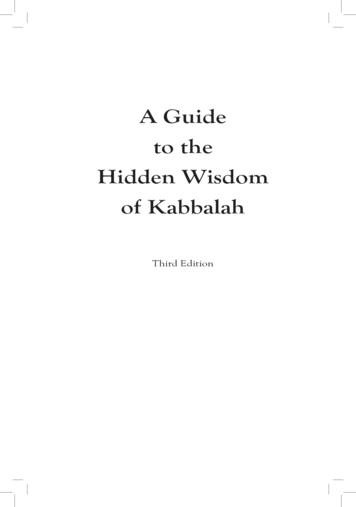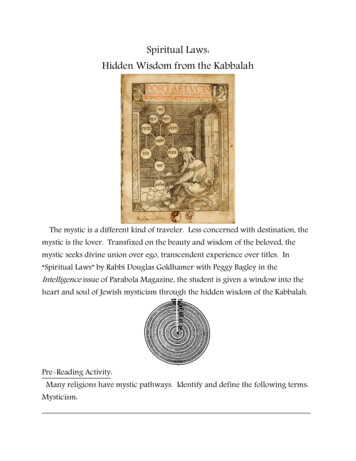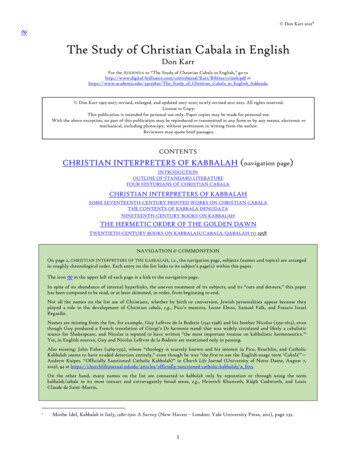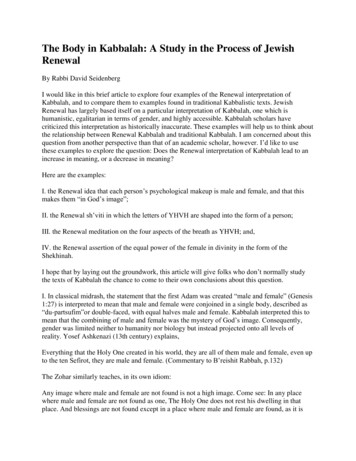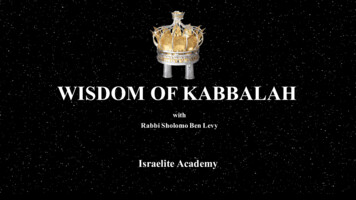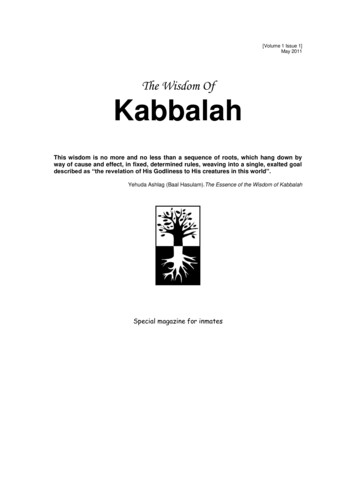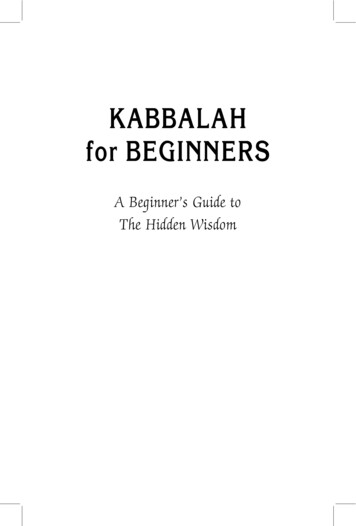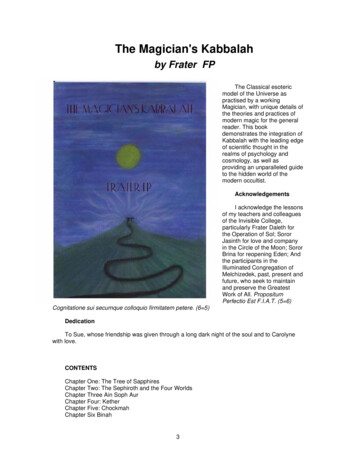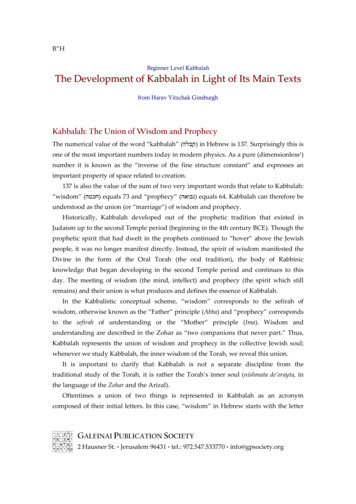
Transcription
B”HBeginner Level KabbalahThe Development of Kabbalah in Light of Its Main Textsfrom Harav Yitzchak GinsburghKabbalah: The Union of Wisdom and ProphecyThe numerical value of the word “kabbalah” ( )קבלה in Hebrew is 137. Surprisingly this isone of the most important numbers today in modern physics. As a pure (dimensionless1)number it is known as the “inverse of the fine structure constant” and expresses animportant property of space related to creation.137 is also the value of the sum of two very important words that relate to Kabbalah:“wisdom” ( )חכמה equals 73 and “prophecy” ( )נבואה equals 64. Kabbalah can therefore beunderstood as the union (or “marriage”) of wisdom and prophecy.Historically, Kabbalah developed out of the prophetic tradition that existed inJudaism up to the second Temple period (beginning in the 4th century BCE). Though theprophetic spirit that had dwelt in the prophets continued to “hover” above the Jewishpeople, it was no longer manifest directly. Instead, the spirit of wisdom manifested theDivine in the form of the Oral Torah (the oral tradition), the body of Rabbinicknowledge that began developing in the second Temple period and continues to thisday. The meeting of wisdom (the mind, intellect) and prophecy (the spirit which stillremains) and their union is what produces and defines the essence of Kabbalah.In the Kabbalistic conceptual scheme, “wisdom” corresponds to the sefirah ofwisdom, otherwise known as the “Father” principle (Abba) and “prophecy” correspondsto the sefirah of understanding or the “Mother” principle (Ima). Wisdom andunderstanding are described in the Zohar as “two companions that never part.” Thus,Kabbalah represents the union of wisdom and prophecy in the collective Jewish soul;whenever we study Kabbalah, the inner wisdom of the Torah, we reveal this union.It is important to clarify that Kabbalah is not a separate discipline from thetraditional study of the Torah, it is rather the Torah’s inner soul (nishmata de’orayta, inthe language of the Zohar and the Arizal).Oftentimes a union of two things is represented in Kabbalah as an acronymcomposed of their initial letters. In this case, “wisdom” in Hebrew starts with the letterGALEINAI PUBLICATION SOCIETY2 Hausner St. Jerusalem 96431 tel.: 972.547.533770 info@gpsociety.org
2chet “prophecy” begins with the letter nun; so their acronym spells the Hebrew wordchen, which means “grace,” in the sense of beauty. Grace in particular refers tosymmetric beauty, i.e., the type of beauty that we perceive in symmetry. Thisobservation ties in with the fact that the inner wisdom of the Torah, Kabbalah is referredto as chochmat ha’chen, which we would literally translate as the wisdom of chen. Chenhere is an acronym for another two words: concealed wisdom ( )חכמה נסתרה . But,following our analysis here, Kabbalah is called chen because it is the union of wisdomand prophecy.Because it comprises both wisdom and prophecy, Kabbalah, the inner soul of theTorah is best suited to provide us with a vision of the perfected, utopian future that theworld will enjoy once the Mashiach is revealed. Studying Kabbalah provides us both atthe individual and the collective levels with the consciousness and strength of characterneeded to envision this future, and work towards it even during the greatest hours ofdarkness.The Evolution of KabbalahIn general there are 5 stages in the revelation of the wisdom of Kabbalah, each stageappearing (one might say, even encoded) within a particular text. Kabbalah analyzeseverything in our world, especially those things that explicitly relate to the Torah,according to pre‐figured basic models that derive from an in‐depth study of the Torah.Naturally, these five stages are significant and should be analyzed based on the fiveascending levels of the soul.* Psyche (nefesh)* Spirit (ruach)* Soul (neshamah) ‐ intellectual dimension* The living one (chayah) ‐ super rational connection of the soul to God* The singular one (yechidah) ‐ is one with God, (described as ʺthe singular one thatmarks You [God] as singular,ʺ )יחידה ליחדך . This level gives the power for total self‐sacrifice, because it is always one with God, whether embodied on earth or not.Stage One: The Book of FormationThe text revealing the first stage that corresponds to the psyche level of the soul is SeferYetzirah (The Book of Formation). Jewish tradition attributes the wisdom in this text tothe first Jew, Abraham. Lengthwise, it is a relatively short text, and most of its contentappears in enigmatic phrases; it appears clear from its language that it indeed has veryancient roots. Explicitly, this means that the wisdom contained in The Book ofGALEINAI PUBLICATION SOCIETY2 Hausner St. Jerusalem 96431 tel.: 972.547.533770 info@gpsociety.org
3Formation antedates the giving of the Torah at Mt. Sinai. Nonetheless, traditionally, thefinal edition of the book as it has come down to us was compiled in the generationbefore the destruction of the Second Temple (1st century CE) by the greatest sage of theTannaic (Mishnah) period, Rabbi Akiva. Rabbi Akiva was also the master and teacher ofRabbi Shimon bar Yochai, the author of the Zohar, literally The Book of Brilliance.Stage Two: The ZoharUnlike The Book of Formation, the Zohar, the text revealing the second stage ofKabbalah, is a very large one. Its content is primarily structured as an interpretation ofthe Bible in general and the Pentateuch, in particular. The Zohar, though using what isnormally less enigmatic language than the Book of Formation, is structurally varied.Some of the content appears as story‐telling, some of it as an in‐depth analysis of higherworlds, the reality of sefirot, the way in which the sefirot develop into partzufim (lit.,persona)2 —spiritual personas3 of the higher worlds, and so on. There are some parts ofthe Zohar (like the Idra Rabbah and Idra Zuta), which remained almost completelyincomprehensible until the Arizal (16th century CE) shed light shed on them (more onthe Arizal in the fourth stage). In the complete corpus of the many writings that make upthe Torah, the Zohar is considered a midrash—a homiletic or hermeneutic discourse onthe Torah.4 Sometimes the Zohar is even referred to as Midrash Rashbi, Rashbi being theacronym of its author’s name: Rabbi Shimon bar Yochai.Though originally composed by Rabbi Shimon bar Yochai in the 2nd century CE, theZohar was not openly published for another 1200 years. During the interim, it waspassed from mentor to disciple. “A thing in its [proper] time is good,”5 and such was thepublic revelation of the Zohar. Immediately upon its revelation, the Zohar spreadthroughout the Jewish world of learning, and many of the Kabbalistic scholars began totry to unlock its secrets, by properly interpreting its myriad of allusions and metaphors.This went on for almost 200 years, until this process reached its zenith with the work ofRabbi Moshe Cordovero (1522‐1570), known by his acronym, the Ramak.Three: The Pomegranate OrchardThe Ramak’s work represents the third stage of the evolution of Kabbalah. Hisinterpretation of the Zohar was based on a rational mindset (not very different from themindset used in explaining other Midrashic literature; see note 3) and a wide andcircumspect knowledge of the entire Torah in all its strata exoteric (revealed) andesoteric (hidden) alike. The Ramak’s commentary on the Zohar, titled Or Yakar, istremendous in its scope, spanning dozens of large volumes. But, his magnum opus wasGALEINAI PUBLICATION SOCIETY2 Hausner St. Jerusalem 96431 tel.: 972.547.533770 info@gpsociety.org
4the volume titled The Pomegranate Orchard (Pardes Rimonim), based on what is perhapsone of the most enigmatic verses in the entire Bible: “Your shoots are an orchard ofpomegranates with pleasant fruits, henna and nard.”This verse is from the Song of Songs, a poetic and metaphoric description of the lovebetween a bride and her groom. Even though all the sages of the Talmudic period knewabout and were involved in the study of Kabbalah, the Talmud does not openly delveinto its mysteries. However, there is one chapter dedicated to this topic: the secondchapter of the tractate of Chagigah. There, the sages who were initiated into the study ofKabbalah are described as having entered the Pardes, the “orchard.” The Hebrew wordpardes is also understood in Kabbalah to be an acronym for the four parts of the Torah:literal, allusive, homiletic/hermeneutic, and secret.6 That the “orchard” contains all fourparts of the Torah implies that it is impossible to truly be initiated into its secretswithout studying the three other strata.7Four: The Tree of LifeBy the work of the Ramak and others on the Zohar many of its mysteries were revealed.Nonetheless, the deepest teachings and concepts could not be fathomed by the humanmind alone if it were not inspired from above by the Almighty. The Holy Ari, theacronym for Rabbi Isaac ben Shlomo Luria, was the new soul8 sent from above andchosen to reveal these. The Ari arrived in the Ramak’s hometown, the holy city of Safed ,on the same day that the Ramak passed away and was being buried.9Beyond having the intellectual skills and knowledge of his predecessors, the Arimerited to receive a completely new revelation of wisdom from Heaven. Though thisnew wisdom could be taught independently, the Ari chose to “enclothe” it as aninterpretation of the Zohar, that is, to teach it in context of the language and style of theZohar. The Ari’s teachings were then compiled into the text titled The Tree of Life (EitzChayim). So all‐inclusive and penetrating were the Ari’s teachings, that a student ofKabbalah who has not yet learnt the fifth level of Kabbalah, will tell you that the classicwork for the study of Kabbalah in our generations is The Tree of Life.Spreading the WisdomThe Arizal explains that as we approach the Messianic era it becomes critical that thestudy of Kabbalah be taught. In his words: “it is a mitzvah [a commandment] to revealthis wisdom now.ʺ This is based on the statement of the Zohar that “with this book [i.e.,the Zohar], we will come out of their exile with mercy”10). Meaning, that the study of theinner dimension of the Torah, as revealed in the Zohar, has the power to prevent theGALEINAI PUBLICATION SOCIETY2 Hausner St. Jerusalem 96431 tel.: 972.547.533770 info@gpsociety.org
5difficult traumatic events otherwise required for us to make the transition from ourpresent state of consciousness to the consciousness of the Messianic era.Even though the Arizal was the first to say that the time has come for Kabbalah to betaught openly, nonetheless, there are still conditions placed upon those who desire tostudy the esoteric dimension of the Torah. On the part of the teacher it is indeed amitzvah to reveal the hidden teachings, but only to those who are already worthy tointegrate them into their lives. The description of what is required of an appropriatestudent is even outlined in the introduction to Eitz Chayim, The Tree of Life, the mostbasic text of the Arizal’s Kabbalah.The Fifth Stage of Kabbalah: ChassidutMore than a century and a half after the Arizal’s statement that the time has come forKabbalah to be revealed, the Ba’al Shem Tov (1698‐1760) founded the Chassidicmovement. As explained in length by one of the greatest Chassidic scholars, Rabbi Isaacof Homil (who was a disciple of Rabbi Shneur Zalman of Liadi, the founder of theChabad branch of Chassidut, his son, Rabbi Dov Ber, and his grandson, the TzemachTzedek), the Ba’al Shem Tov’s teachings in particular and Chassidut in general are a finaltier of Kabbalah. They are a unique revelation of the Divine wisdom of Kabbalah in thesense that they form a new corpus of teachings that as a whole provide a deeper insightand a more advanced conceptual scheme than ever revealed before with which tounderstand and internalize the teachings of the Zohar and the Arizal. Chassidut is thusthe fifth stage of the revelation of Kabbalah.But, the Ba’al Shem Tov’s Kabbalah is not different only in its breadth of explanation;it is also wider in its scope. Whereas the Arizal still imposed limitations on who isworthy to study Kabbalah, the Ba’al Shem Tov advocated a radically new approach. TheBa’al Shem Tov experienced an elevation of his soul to the dwelling place of theMashiach in heaven, where the Mashiach revealed to him, that the redemption wouldoccur once his [the Ba’al Shem Tov’s] wellsprings of teaching would spread forth to themost remote extremes. Subsequently, the Ba’al Shem Tov explained that the “mostremote extremes” specifically refers to those Jews who until now could not have beenconsidered sanctified enough to study Kabbalah. Obviously, spreading the wellspringsof Kabbalah to these extremes means specifically addressing every single Jew, regardlessof level of observance or commitment to the Torah. Not only that, but even non‐Jews,who also require the wisdom of Kabbalah in order to participate in the redemption in acompassionate and merciful manner, should also be addressed and taught those parts ofthe wisdom that pertain to them. This implies there really are no longer any conditionsGALEINAI PUBLICATION SOCIETY2 Hausner St. Jerusalem 96431 tel.: 972.547.533770 info@gpsociety.org
6placed on the study of Kabbalah. Since all souls require this wisdom to rectifythemselves, there is also no difference between genders. Until the coming of theMashiach it is our task to do all in our power to spread the wellsprings of Chassidut, thefifth level of Kabbalah.Revealing the ConcealedIt is important to mention that whenever we speak of “new teachings” we of coursemean not that some new Torah has been given from God through someone, but ratherthat some righteous individual has merited revealing hidden parts of the Torah thatwere always present but remained concealed until that point in time (for reasons knownonly to God, in His providence to bring creation and history to the utopian state forwhich the world was created). Those unique souls sent from Heaven at certain criticalmoments in history to reveal new dimensions of the Torah will of course nevercontradict or nullify any of the Torahʹs laws or teachings that had been revealed untilthat point in time.Rabbi Shneur Zalman, the found of Chabad, stated that “there will not be a secondgiving of the Torah,” meaning that all new teachings must always truly be founded onthe Torah as it has been transmitted and developed from generation to generation. TheTorah that was given by God at Mt. Sinai already contains all the new teachings andunderstandings of all the generations up to and including even the deepest revelationsthat will be taught by the Mashiach. In fact, the prophets clearly stated that just beforethe final revelations of the Torah by the Mashiach, prophecy will return to the Jewishpeople. The purpose of this prophecy is, again, not to reveal a “new” Torah, but rather toprepare the soul so that it can integrate the depth of the revelation of the Torah’s hiddenteachings as they will be revealed by the Mashiach.The Road to ProphecyLet us now see how the 5 stages of the development of Kabbalah relate to the 5 aspectsof the soul:* psyche ‐ nefesh (natural faculties)* spirit ‐ ruach (emotional faculties)* soul ‐ neshamah (mental faculties)* the living one ‐ chayah (super‐rational faculties)* the singular one – yechidah (one with God)GALEINAI PUBLICATION SOCIETY2 Hausner St. Jerusalem 96431 tel.: 972.547.533770 info@gpsociety.org
7As mentioned, the 5 stages of Kabbalah constitute an unfolding of the Jewishconsciousness. We find in the prophets that real prophecy will return to the Jewishpeople just before the final redemption. Essentially this is not only a sign of the comingredemption, it is also a prerequisite. As we mentioned in the beginning, Kabbalah isactually the unification of wisdom with prophecy and is what prepares the Jewishpeople for the return of prophecy.The first text, Sefer Yetzirah, talks about the different phenomena of nature (theseasons, the days of the week, the planets, the human body, etc.) and corresponds themwith the letters of the Hebrew alphabet, thus it corresponds with the revelation of thenatural, psyche (nefesh) aspect of the soul.The second text, the Zohar, when stripped of the deep contemplative explanationsoffered on this text by the later stages and read at face value, has the special power toarouse the spirit (ruach) of the soul. As stated by one of the Rebbe’s of Chabad, as a text,there is nothing like the Zohar to arouse a person’s emotions. Of course, the spirit aspectof the soul includes the emotional faculties.The Kabbalists of the third stage, epitomized by the Ramak and his work, sought touse their mental faculties to comprehend the inner mysteries of the Zohar. This stage wascontinually underscored by Judaism’s greatest philosophical text, Maimonides’ Guide tothe Perplexed. The ideal was to unify the Zohar’s esoteric wisdom with the Jewishphilosophical tradition; to unite Kabbalah with Jewish philosophy. The neshamah aspectof the soul11 contains its mental faculties, which unfolded and reached an apex duringthis stage.The new revelation of the Arizal taxes the mind’s faculties to the limit, but moreimportantly it challenges the soul to go beyond the mind’s rational approach. Its essenceis super‐rational, though the Arizal did present this essence in intellectual terms. Unlikereading the Zohar which leads to an emotional experience, reading the Eitz Chayimrequires a deep intellectual endeavor, which still leaves a sense of being somethingbeyond the intellect. Thus the Arizal’s Kabbalah serves to unfold the level of soul’saspect of chayah. The chayah is described as having the quality of “touching/not‐touching”; it hovers ever so closely to our mind, yet always eludes it.The final revelation is known in Chassidic tradition as the “soul of the Kabbalah ofthe Arizal,” or the “soul of the soul of the Torah.” The classic text of Chassidut is theTanya, written by Rabbi Shneur Zalman of Liadi. One of the most important teachings inthe Tanya is that the Jewish soul is ʺan actual part of God.ʺ12 Though this thoughtappears in earlier Kabbalistic texts (in various formulations),13 it was never stated sounequivocally and had not yet formed the basis for an entire conceptual scheme as itGALEINAI PUBLICATION SOCIETY2 Hausner St. Jerusalem 96431 tel.: 972.547.533770 info@gpsociety.org
8does in the Tanya. What this statement says is that we have an eternal continualconnection with God, and that every action that we do reflects the essence of the Divine.Chassidut thus reveals the level of Divinity before the initial contraction of God’s infinitelight that allowed the creation of finite reality; Chassidut thus reveals the infinitecapacity of the Jewish soul. In order to understand how novel a revelation this is, theArizal did not expound regarding the stages that came before the initial contraction. Itwas left to Chassidut to reveal and unfold these stages, in virtue of the fact that theessence of our Divine soul was indeed there. Chassidut is revealing a pristine,unconscious memory of the soul before creation.When a new disciple would come to the Ba’al Shem Tov, the first question he wasasked was “what do you remember?” The Ba’al Shem Tov was jingling the deepestlevels of the new disciple’s soul preparing him for the study of Chassidut. In the Arizal’sKabbalah there was also “memory triggering” but it involved “recollecting” one’sprevious incarnations, which of course do not reveal the soul’s existence as it was beforethe creation of the world, when it was still an actual part of God, the yechidah, thesingularity aspect of the soul.aspect of the soulcentral textdevelopspsyche (nefesh)Sefer Yetzirahunderstanding of natural worldspirit (ruʹach)Zoharemotional realmsoul (neshamah)Pardes Rimonim intellectual facultiesliving one (chayah)Eitz Chayimsingular one (yechidah) Tanyasuper‐rational undersandingoneness with GodSeeing the FutureA well‐known Chassidic story illustrates this point well:After the Maggid of Mezheritch passed away (the Maggid was the Ba’al Shem Tov’ssuccessor), the disciples each looked for a Rebbe to follow. The eldest of the discipleswas Rebbe Menacham Nachum of Chernobyl. Rebbe Shneur Zalman, the founder ofChabad, did not follow his close friend Rebbe Nachum, but instead looked to RebbeMenachem Mendel of Vitebsk for guidance. Rebbe Shneur Zalman and Rebbe Nachumwould visit one another once a year on Sukot.On one of those visits, when they were sitting and discussing the deep mysteries of theTorah in the sukah, Rebbe Nachum asked Rebbe Shneur Zalman: “Why did you takeRebbe Menachem Mendel as your Rebbe and not me?”GALEINAI PUBLICATION SOCIETY2 Hausner St. Jerusalem 96431 tel.: 972.547.533770 info@gpsociety.org
9Rebbe Shneur Zalman replied: “I once saw him when he was giving audience and Irealized that everything that the person seeking his council had done in his life wasknown to him.”Rebbe Nachum shrugged as if to say that he too saw past actions.Rebbe Shneur Zalman continued: “I then realized that not only could he see all hisactions in this present lifetime, he also was aware of all of the person’s previousincarnations since the six days of creations.”Rebbe Nachum shrugged again.Finally, Rebbe Shneur Zalman said: “In the end I realized that not only could he seehis past actions and past incarnations, he could also see everything that this soul wasdestined for in the future until the coming of the Mashiach and after.”At that moment Rabbi Nachum raised his brows in wonder, thereby acknowledgingRabbi Shneur Zalmanʹs choice of a Rebbe, but the conversation abruptly ended, as theChassidim, who had been intently listening to the holy words of the two tzadikim fromon top of the sukah, suddenly moved and were heard .Everything that a person has done in his lifetime up to the present moment, in deed,word, and thought, corresponds to the first three levels of the soul: nefesh, ruach andneshamah. These were apparent to the Kabbalists before the Arizal.Past incarnations, which the Arizal focused on, correspond to the chayah aspect of thesoul.But, in order to see a soul’s destiny in the future, it is necessary to see the soul as it isan actual part of God, for whom past, present, and future all exist at once. The ability ofRebbe Menachem Mendel to see a person’s yechidah was what convinced Rebbe ShneurZalman to seek his guidance.aspect of the soulseespsyche, spirit, and soul past actions (deeds, words, and thoughts)living onepast incarnationssingular onefuture destinyThe Dangers of KabbalahThe first thing that one should ask before learning Kabbalah is what is the correct way todo this without endangering oneself due to the highly energetic (psychological) andconsciousness altering (spiritual) power of this part of the Torah. Past experienceprovides many examples of people who lost their mind, or were psychologically hurtfrom studying Kabbalah in an inappropriate manner. Most of these individuals were notentirely stable to begin with. Nonetheless, there is no question that the improper studyof Kabbalah contributed to some extent to their psychological breakdown.GALEINAI PUBLICATION SOCIETY2 Hausner St. Jerusalem 96431 tel.: 972.547.533770 info@gpsociety.org
10In our generation, this is less frequent, because those people who are notpsychologically stable usually seek professional help of some sort and are in some kindof treatment program. Nonetheless, while many of the psychological dangers are nolonger so much of an issue, spiritual dangers still exist. The spiritual dangers that we arespeaking of are of the type that place a person’s spiritual and consequently physicalwell‐being in jeopardy.Kabbalah Is a Part of the Torah as a WholeThe first danger lies in the notion that it is possible to study Kabbalah withoutperforming commandments (mitzvot). The Jewish people received the Torah at Mt. Sinaion the basis of their declaration “We will do and we will understand.”14 Action createsvessels, while understanding brings light, or soul into these vessels. It is important toknow that the ultimate purpose for which God created the world was the formation ofvessels, by living a good life by emulating God—the essence of the Torah and its 613commandments for Jews and 7 commandments for humanity.The attempt to have mystical experiences or even prophetic experiences withoutcreating the proper vessels to contain them is hazardous, because it is like creating “asoul without a body.” Most times these experiences themselves are simply illusory, andthere is nothing but the person’s imagination at work. But, if they do become real then inessence they are the equivalent of death, because that is essentially what “a soul withouta body” is. The importance of creating vessels parallels the importance that the Torahplaces on life. In this sense, the Torah’s commandments “give life,”15 that is, they makelife possible by forming the vessels into which the soul enters.The Torah tells us of great souls, like the two eldest sons of Aaron (Moses’ brother,and the High Priest) Nadav and Avihu, who were deeply immersed in the mostprofound mysteries of the Divine, yet, because they did not perform a commandment ofGod, perished while serving in the Tabernacle.16 In Kabbalah, their mistake is describedas an overly enthusiastic “run” to God, without the anchor provided by the properperformance of commandments that allows the person to remain grounded, even whiletranscending to the highest levels of spirituality. This is the essence of the first danger:without being properly grounded through the performance of mitzvot, a person caneasily lose touch with reality.We mentioned that from the time of the Ba’al Shem Tov, the study of the innerdimension of the Torah became permissible and even necessary for everyone, men andwomen alike. This is especially true of Kabbalah as it appears at its highest level ofrevelation, in Chassidut. Kabbalah as manifest in Chassidut is a must for all. TheGALEINAI PUBLICATION SOCIETY2 Hausner St. Jerusalem 96431 tel.: 972.547.533770 info@gpsociety.org
11Lubavitcher Rebbe writes that the permissibility and advisability of studying Kabbalahas it appears in the Arizal’s Eitz Chayim depends on the level of yearning that eachparticular person has for this type of study. In order to safely enter into and depart fromthe figurative orchard, the pardes,17 it is necessary to be well protected from overlypowerful energy and well‐grounded in reality through a serious commitment to theentire Torah.The teacher must never give the false conception that commitment to the Torah as awhole is not required by someone wishing to learn Kabbalah. Nonetheless, the teacherhas to know how to fulfill the Ba’al Shem Tov’s legacy that even those Jews who are stillfar from the Torah study this wisdom, even though many Jews who have grown updistant from the Torah are not initially willing to take on the commitment of performingcommandments. The real teacher of Kabbalah has to know how to properly take the riskof bringing someone who is not yet ready to commit to the Torah as a whole closer tothe Torah.Real, Knowledgeable, and Inner TeachersReal: The second danger involves who one chooses to learn Kabbalah from. Even if aperson is willing to live according to the Torah as part of the study of Kabbalah, he orshe may nonetheless be receiving wisdom from an inauthentic source.Let us give some examples of false sources. If you go to see some so‐called kabbalistand he starts performing all kinds of calculations on your name (and your spouse’sname) and his conclusion is that either your name is no good and has to be changed, oryou are not a good match for your spouse, then you can be a hundred‐percent certainthat this person is a charlatan. You would do best to keep as far away as possible fromsomeone like this. The Arizal impressed upon us that in our generations there is nolonger any need for, or legitimacy in using practical Kabbalah.18Knowledgeable: Secondly, there are many teachers who though they may meanwell, are actually ignorant when it comes to the rest of the Torah. Because theirknowledge of the revealed part of the Torah is so lacking, they cannot possible fullyunderstand its concealed facets; consequently, whether consciously or unconsciously,they teach incorrect knowledge.19Inner: Finally, an even more subtle flaw regarding the source of one’s learning is thatmany of the teachers teaching today only understand the external aspects of Kabbalah.The largest part of the Arizal’s teachings is based on the distinction between externaland internal aspects of things.20 Even someone who knows the Torah and knowsKabbalah, may be wholly lacking an inner understanding of them. Inner understandingGALEINAI PUBLICATION SOCIETY2 Hausner St. Jerusalem 96431 tel.: 972.547.533770 info@gpsociety.org
12refers to being able to not only intellectually understand the meaning of the teachings ofKabbalah, but rather, as explained in length in Chassidut, to be able to experience themin a rectified and holy manner. An authentic teacher of Kabbalah understands and relaysto his students that Kabbalah is not referring solely to external reality. Recognizing ateacher who understands the wisdom of Kabbalah in an inner manner is dependent onthe student’s sensitivity to truth.The previous Lubavitcher Rebbe, Rabbi Yosef Yitzchak, said something veryimportant in this respect. If a person gets used to looking at the world externally, it ruinshis or her ability to later acquire an inner point‐of‐view or perspective. It is as though theexternal perspective does some kind of mental or spiritual damage to the Divine soul.To explain this flaw a bit more, we may use the statement of the sages that a womanforms a bond only with the first man who makes her into a vessel (i.e., that she
here is an acronym for another two words: concealed wisdom (הרתסנ המכח). But, following our analysis here, Kabbalah is called chen because it is the union of wisdom and prophecy. Because it comprises both wisdom and prophecy, Kabbalah, the inner soul of the


